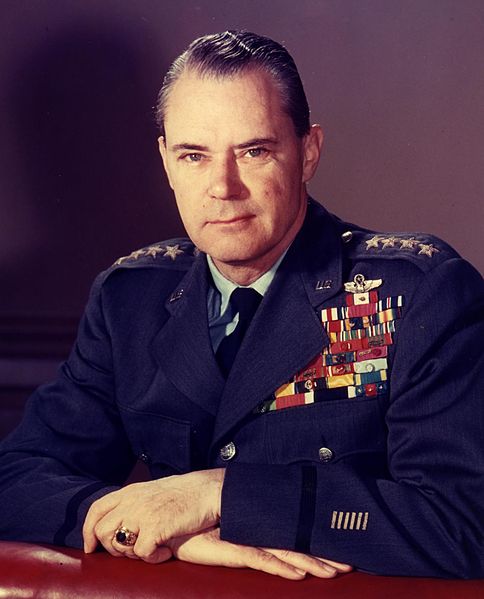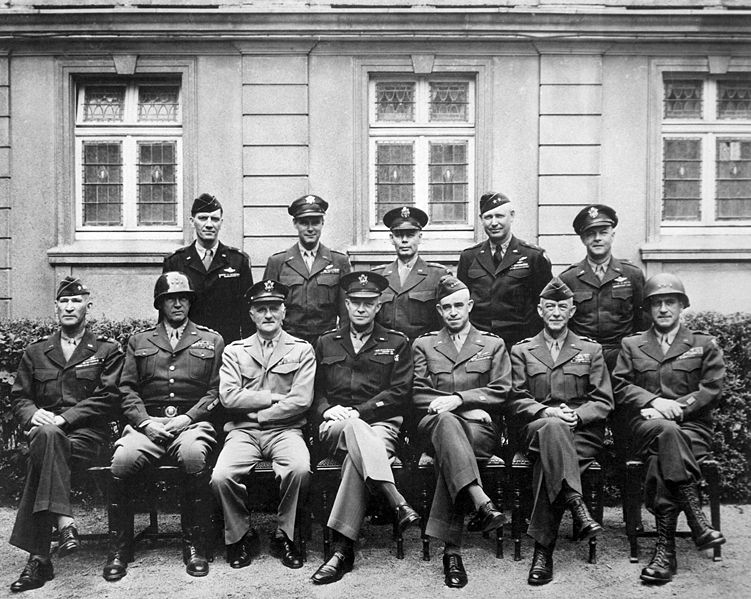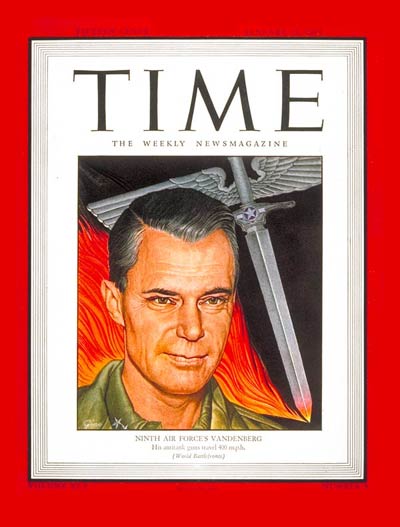Hoyt
Sanford Vandenberg (January 24, 1899 – April 2, 1954)
was a U.S. Air Force general, its second Chief of Staff,
and second Director of Central Intelligence.
During
World War II, Vandenberg was the commanding general of
the Ninth Air Force, a tactical air force in England and
in France, supporting the Army, from August 1944 until
V-E Day. Vandenberg Air Force Base on the central coast
of California is named for General Vandenberg. In 1946,
he was briefly the U.S. Chief of Military Intelligence.
He was also the nephew of Arthur H. Vandenberg, a former
U.S. Senator from Michigan.

Hoyt
Vandenberg
Military
career
Vandenberg
was born in Milwaukee, Wisconsin. He grew up in Lowell,
Massachusetts, spending his teenage years there. He graduated
from the United States Military Academy on June 12, 1923,
and was commissioned a second lieutenant in the Air Service.
Vandenberg
graduated from the Air Service Flying School at Brooks
Field, Texas, in February 1924, and from the Air Service
Advanced Flying School at Kelly Field, Texas, in September
1924.
His
first assignment was with the 90th Attack Squadron, part
of the 3d Attack Group at Kelly Field. Vandenberg was
appointed commander of the 90th AS on January 1, 1926.
In 1927, he became an instructor at the Air Corps Primary
Flying School at March Field, Calif. In 1928 he was promoted
to first lieutenant. In May 1929 he went to Wheeler Field,
Hawaii, to join the 6th Pursuit Squadron, and assumed
command of it the following November.
Returning
in September 1931, he was appointed a flying instructor
at Randolph Field, Texas, and became a flight commander
and deputy stage commander there in March 1933. He entered
the Air Corps Tactical School at Maxwell Field, Alabama,
in August 1934, and graduated the following June. Two
months later, he enrolled in the Command and General Staff
School at Fort Leavenworth, Kansas; he completed the course
in June 1936 and was promoted to the rank of captain.
He then became an instructor in the Pursuit Section of
the Air Corps Tactical School, where he taught until September
1936, when he entered the Army War College, where he specialized
in air defense planning for the Philippines.
After
graduating from the War College in June 1939, Vandenberg
was assigned to the Plans Division in the Office of the
Chief of Air Corps, selected personally by its head, Brig.
Gen. Carl A. Spaatz, whom he had met at the Command and
General Staff College. In September 1939 and the autumn
of 1940, Vandenberg developed two air plans for the Philippine
Department, the second based on Royal Air Force interceptor
operations in the Battle of Britain, but neither was adopted
by the War Department when the Roosevelt Administration
reaffirmed its long-standing opposition to any plan that
called for extensive reinforcement of the defenses in
the Philippines. In 1940, Vandenberg was promoted to major
and in 1941, to lieutenant colonel.
A
few months after the United States entered World War II,
he was promoted to colonel and became operations and training
officer of the Air Staff. For his services in these two
positions he received the Distinguished Service Medal.
In
June 1942, Vandenberg was assigned to the United Kingdom
and assisted in the organization of the Air Forces in
North Africa. While in Great Britain he was appointed
the chief of staff of the Twelfth Air Force, which he
helped organize. In December 1942 Vandenberg earned the
promotion to Brigadier General. On February 18, 1943,
Vandenberg became the chief of staff of the Northwest
African Strategic Air Force (NASAF) which was under the
command of Major General James Doolittle. NASAF was the
strategic arm of the new Northwest African Air Forces
(NAAF) under Lieutenant General Carl Spaatz. With NASAF,
Vandenberg flew on numerous missions over Tunisia, Pantelleria,
Sardinia, Sicily, and Italy. He was awarded both the Silver
Star and the Distinguished Flying Cross for his services
during this time. For his organizational ability with
the 12th Air Force and his work as chief of staff of the
NASAF he was awarded the Legion of Merit.
In
August 1943, Vandenberg was assigned to Air Force headquarters
as Deputy Chief of Air Staff. In September 1943, he became
head of an air mission to Russia, under Ambassador Harriman,
and returned to the United States in January 1944. In
March 1944, he earned the promotion to Major General and
then he was transferred to the European theater; in April
1944, he was designated the Deputy Air Commander in Chief
of the Allied Expeditionary Forces and the Commander of
its American Air Component.
In
August 1944, Vandenberg assumed command of the Ninth Air
Force. On November 28, 1944, he received an oak leaf cluster
to his Distinguished Service Medal for his part in planning
the Normandy invasion. He was promoted to Lieutenant General
in March 1945.

Eisenhower
(seated, middle) with other U.S. Army officers, 1945.
From left to
right, the front row includes Simpson, Patton, Spaatz,
Eisenhower, Bradley, Hodges,
and Gerow. Vandenberg is second from the left in the second
row.
He
was appointed the Assistant Chief of Air Staff at the
Army Air Forces (USAAF) headquarters in July 1945. In
January 1946, he became director of Intelligence on the
War Department general staff where he served until his
appointment in June 1946, as Director of Central Intelligence,
a position he held until May 1947.
Lieutenant
General Vandenberg returned to duty with the Air Force
in April 1947, and on June 15, 1947, became the Deputy
Commander in Chief of the Air Staff. Following the division
of the United States Department of War into the Departments
of the Army and the Air Force, Lieutenant General Vandenberg
was designated the Vice Chief of Staff of the Air Force
on October 1, 1947, and promoted to the rank of General.
Even
when he was at the pinnacle of his military career, General
Vandenberg’s boyish good looks and outgoing personality
often made him the target of attacks on his credibility
and experience. But the attention that his appearance
brought on was not all bad, having appeared on the covers
of Time and LIFE magazines. The Washington Post once described
him as “the most impossibly handsome man on the entire
Washington scene,” and Marilyn Monroe once named
Vandenberg, along with Joe DiMaggio and Albert Einstein,
as one of the three people with whom she would want to
be stranded on a deserted island.

On
the January 15, 1945, cover of Time magazine
On
April 30, 1948, General Vandenberg became the Chief of
Staff of the United States Air Force, succeeding General
Carl Spaatz. He was renominated by President Harry S.
Truman for a second term as Air Force Chief of Staff on
March 6, 1952. The nomination was confirmed on April 28,
1952, with Vandenberg serving until June 30, 1953.
A
controversy arose while he was the Air Force Chief of
Staff, when he opposed the Secretary of Defense Charles
Erwin Wilson on a proposed $5 billion budget reduction
for the Air Force. General Vandenberg maintained that
the cut backed by Wilson would reduce U.S. military aviation
to a "one-shot Air Force", inferior to that
of the Soviet Union. He said it was another instance of
"start-stop" planning of a kind that had impeded
Air Force development in previous years. The cut in appropriations
went into effect in July 1953, immediately after his retirement
from the Air Force.
Post-military
life
A
scratch golfer, General Vandenberg spent every free moment
on the golf courses, but he was also a lover of movies,
Westerns, and scotch. Unfortunately, his last months in
uniform were painful, unhealthy ones. General Vandenberg
retired from active duty as a result of major illness
on June 30, 1953, and died nine months later at the Walter
Reed Army Medical Center from prostate cancer at the age
of 55. His remains are buried in Section 30 of the Arlington
National Cemetery.
His
wife, Gladys Rose Vandenberg, started the concept of the
Arlington Ladies while Vandenberg was Air Force Chief
of Staff. The program provides that a military lady of
the appropriate service represents the service chief at
all military funerals at Arlington Cemetery.[4] She was
buried alongside her husband in Arlington National Cemetery
upon her death on January 9, 1978. They are survived by
their children, Gloria Miller, and retired Major General
Hoyt S. Vandenberg, Jr., USAF.
On
October 4, 1958, the missile and aerospace base at Camp
Cooke in Lompoc, California, was renamed Vandenberg Air
Force Base. In July 1963, the instrument ship USAF General
Hoyt S. Vandenberg (T-AGM-10) was renamed at Cape Canaveral,
Florida, for duty on the Eastern Space and Missile Range
in the Atlantic. One of the two cadets' dormitories at
the United States Air Force Academy, Vandenberg Hall,
is also named in his honor. In addition, a popular enlisted
"hangout" for technical school Airmen at Keesler
AFB, Mississippi, is named in his honor. The Vandenberg
Esplanade, located along the Merrimack River in Lowell,
Massachusetts and part of the Lowell Heritage State Park,
is named in his honor.
Decorations
General
Vandenberg was awarded the Distinguished Service Medal
with one oak leaf cluster, the Silver Star, the Legion
of Merit, the Distinguished Flying Cross, the Air Medal
with four oak leaf clusters, the Bronze Star, the World
War II Victory Medal, the American Campaign Medal, the
American Defense Service Medal, and the European-African-Middle
East Campaign Medal.
His
foreign decorations include the Mexican Military Order
of Merit; Netherlands Order of Orange Nassau (Grand Officer
with Swords); Brazilian Cruzeiro do Sul (Grand Officer),
and Medal of War; Luxembourg Order of Adolphe of Nassau
(Grand Cross), and Croix de Guerre; Order of Leopold (Belgium)
(Grand Officer with Palms); and French Croix de Guerre
with Palms; British Order of the Bath (Knight Commanders
Cross); Polish Order of Polonia Restituta (Commander's
Cross with Star); Portuguese Order of Aviz, Gra Cruiz;
Egyptian Order of the Nile, Grand Cordon; Chinese Order
of Pao Ting (Tripod with Grand Cordon); Chilean Medallia
Militar de Primerera Clase; Argentine General Staff Emblem
and the Grand Cross of the Military Order of Italy.
The
Manuscript Collection of Hoyt S. Vandenberg at the Library
of Congress as of November 2005 is Classified information.
Source:
http://en.wikipedia.org/wiki/Hoyt_Vandenberg